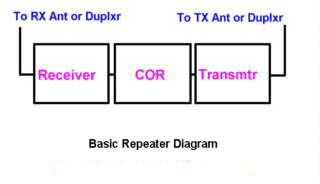

The COR detects the presence of a received signal through the squelch on the receiver. Some repeaters require only those 3 devices, provided the operators identify the system. Adding some method of repeater station identification per FCC regulations (in U.S.A.) makes repeater operations easier. Generally accepted methods in the amateur service include a morse code identifier, a tape recorded announcement at the repeater (rarely used any longer), a digitally recorded voice announcement, or a digitally synthesized voice announcement. Most of these methods are done today with a repeater controller. This specialized device usually contains the COR and identifier components, and many repeater owners or clubs will have an autopatch installed to allow users the capability of making a local phone call, of course emergency calls and any emergency messages or "priority traffic" take priority.
If the repeater retransmits the signal in the same band, it can be operated in at least three configurations. The most reliable method is using a set of "cans" or duplexers. These cavities are specially designed filters with a very narrow passband which are optimized for use on the repeater's transmit and receive frequencies only, and any retuning of these cavities must be done with an RF spectrum analyzer and sweep or signal generator(s) by appropriately trained technicians. The second method commonly used is to separate the transmit and receive antennas as far as possible to avoid desensing (the condition where the nearby transmitting signal in the same band is great enough where "capture effect" as a result will desensitize your receiver.) This is called dual-antenna operation and usually requires some trial-and-error to optimize. The third method is to use separate receive and transmit sites on the same repeater pair, therefore a link or short range transmission between the separate sites in a different band is required.
Since there are pros and cons to each approach, this is not
necessairily a recommendation as to what you should do with your operation
if you are proposing such. Site limitations, potential or known interference
problems with your site such as high power paging systems and intermod, and
of course economic considerations will undoubtedly factor in the decisions
you make with your repeater system.
For commercial and amateur systems, the first method stated earlier is
by far the most widely used. Whatever method you choose for your system,
I hope you or your group the best of success in engineering a well functioning
"machine" that you can take much pride in.
(back to the NN5NN Repeater page)